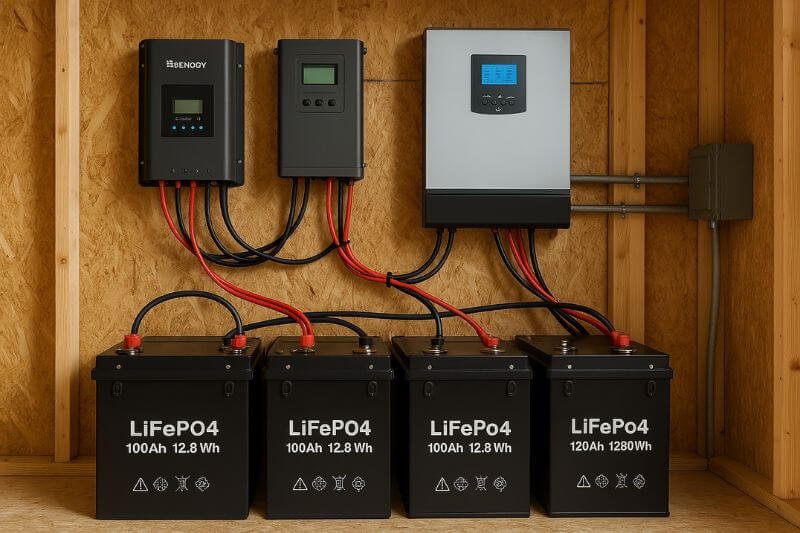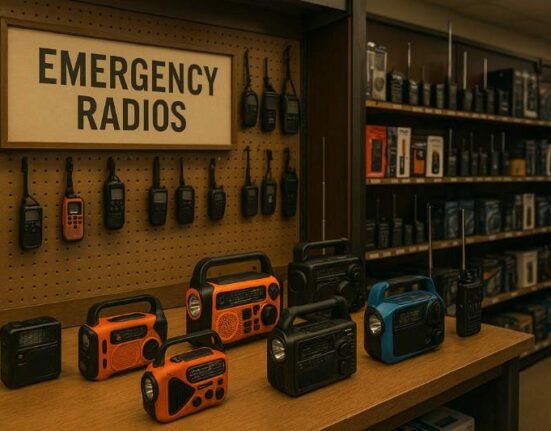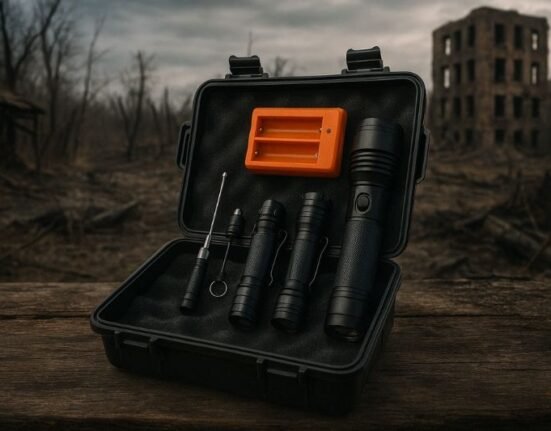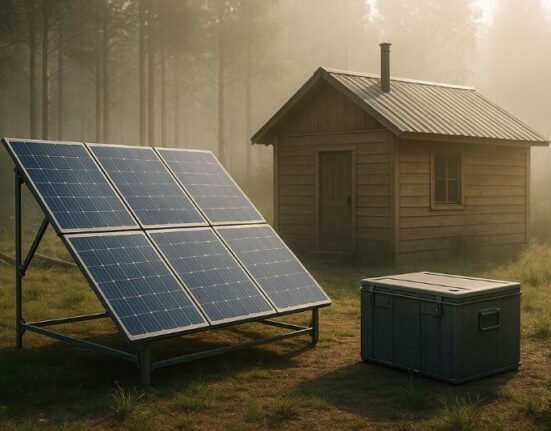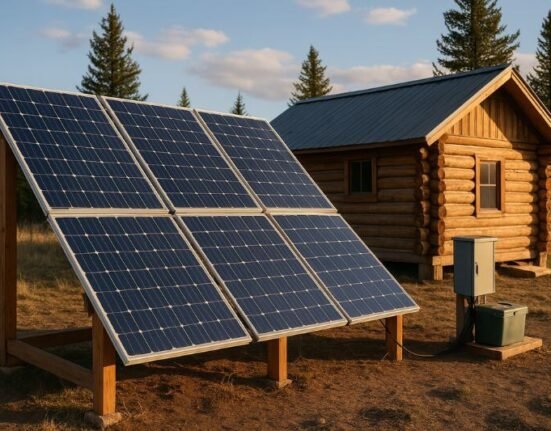🔋 Introduction – Off-grid battery systems are the backbone of true energy independence.
When it comes to off-grid living, solar panels may get all the attention — but it’s the battery system that truly determines whether you’ll have power when it matters most. Off-grid battery systems are the core infrastructure of any self-sustaining energy setup. They store the energy you harvest during the day and release it when the sun is gone, the grid is down, or survival depends on it.
In this guide, we’ll walk you through the top 5 battery systems trusted by real-world preppers, off-grid homesteaders, and remote field operators — not just based on specs, but on resilience, efficiency, and field-proven reliability.
🔧 Part 1: Understanding Off-Grid Battery Systems
⚙️ What Is an Off-Grid Battery System?
An off-grid battery system is a storage bank that captures and holds electricity from renewable sources — primarily solar, but also wind or micro-hydro — for use when no generation is available. Unlike grid-tied solar, which feeds excess power back into the public system, off-grid setups rely entirely on batteries for continuity.
Without a reliable battery system, your off-grid lifestyle quickly becomes fragile. Powering essential devices like:
- Refrigerators
- Water pumps
- Communication radios
- Lights
- Medical devices
…requires stored power — especially at night, during storms, or in winter.
🔋 Core Types of Batteries for Off-Grid Use
There are four main types of batteries you’ll find in modern off-grid solar power systems:
| Type | Key Traits | Lifespan | Cost | Maintenance |
|---|---|---|---|---|
| Flooded Lead-Acid (FLA) | Cheap, requires regular refilling | 3–5 years | 💲 | High |
| AGM (Absorbent Glass Mat) | Spill-proof, sealed version of FLA | 4–6 years | 💲💲 | Low |
| Gel Cell | Great heat resistance, sealed | 5–7 years | 💲💲 | Low |
| LiFePO4 (Lithium Iron Phosphate) | Lightweight, deep cycles, fast charging | 10–15 years | 💲💲💲💲 | Very Low |
✅ Pro tip: If budget allows, LiFePO4 batteries are the gold standard for long-term off-grid power.
⚠️ Why Battery Choice Matters More Than Panel Count
Many first-time preppers think “more panels = more power.” But here’s the truth: without the right battery bank, those panels won’t help you when you actually need power — like during the night or a snowstorm.
Poor batteries:
- Lose charge quickly
- Can’t handle deep discharges
- Die early (especially in cold temps)
- Require frequent replacement
Reliable batteries:
- Store days of energy
- Withstand thousands of charge/discharge cycles
- Power your gear efficiently under pressure
“The battery system is the survivalist’s energy vault — not the panels, not the wires. Choose your vault wisely.” — Prepper Grid Journal, 2024
🔌 Sizing Your Battery Bank Properly
Before reviewing specific battery brands or models, you need to calculate your daily energy needs — just like with solar panel sizing.
- Add up all the devices you plan to run.
- Multiply by hours used per day to get total watt-hours.
- Convert to amp-hours using:
Total watt-hours ÷ system voltage (12V, 24V, or 48V)
💡 Example:
- 2000 Wh/day usage
- 24V battery system
= 2000 ÷ 24 = ~83.3 Ah/day
Multiply by 2 or 3 to store multiple days’ worth of energy.
🔐 What Makes a Battery “Survival-Grade”?
When evaluating off-grid battery systems, we consider five key survival criteria:
- Cycle Life – How many times it can charge/discharge before degrading
- Depth of Discharge (DoD) – How much of its capacity is usable
- Cold Weather Performance – Can it operate below freezing?
- Scalability – Can it grow with your system?
- Shock & Vibration Resistance – Especially for mobile/bug-out applications
Only batteries that pass all five categories make our Top 5 list.
🔋 Part 2: The Top 5 Off-Grid Battery Systems in 2025
These five battery systems are widely recognized across the survivalist, homesteading, and vanlife communities. They’ve been tested in deserts, mountains, snowstorms, and mobile rigs — and they’re known for real reliability when the grid goes dark.
🥇 1. Battle Born LiFePO4 100Ah 12V
Focus: Resilience, long lifespan, lightweight portability
Why It’s Trusted:
Battle Born is one of the most widely respected names in off-grid lithium batteries. Built in the U.S., their 100Ah model uses top-tier LiFePO4 cells, is protected by a smart BMS, and is drop-in ready for replacing lead-acid systems.
Key Specs:
- Voltage: 12V
- Capacity: 100Ah (1200 Wh)
- Weight: 31 lbs
- Cycles: 3000–5000+
- Depth of Discharge: 100%
- Warranty: 10 years
Pros:
- Maintenance-free
- Extremely long cycle life
- Compact and lightweight
- Excellent cold-weather performance (with optional heater)
Cons:
- Higher upfront cost (~$900–1000)
- Only available in 12V (unless you configure banks)
Use Case: Perfect for cabins, RVs, bug-out vehicles, or scalable home systems.
“We’ve run these batteries hard for five years in sub-zero temps. They still deliver.” — Alaska Off-Grid Radio Network
🥈 2. SOK Battery LiFePO4 206Ah 12V
Focus: Affordability + build quality
Why It’s Trusted:
SOK has made a name in the survivalist community for delivering premium performance at mid-tier pricing. The 206Ah model is rugged, easy to repair (modular case), and includes heat pads and metal casing — ideal for off-grid installs in tough conditions.
Key Specs:
- Voltage: 12V
- Capacity: 206Ah (≈ 2.5 kWh)
- Weight: 50 lbs
- Cycles: 4000–8000
- DoD: 100%
- Warranty: 7 years
Pros:
- Outstanding value (~$800–900 for double the capacity of Battle Born)
- Heated model available for cold climates
- User-serviceable design
Cons:
- Heavier than other lithium options
- Bulkier size
Use Case: Best for fixed off-grid homes or cabins that need deep reserves.
🔗 Pro Tip: Pair two SOK 206Ah in parallel for a rock-solid 5 kWh system.
🥉 3. EG4 LL Lithium Battery 48V 100Ah
Focus: High-capacity 48V systems
Why It’s Trusted:
EG4 is popular among solar DIYers for large-scale, efficient storage. Their 48V rack-mount LiFePO4 battery holds a massive 5.12 kWh, is UL-certified, and includes smart monitoring via RS485/RS232/Bluetooth.
Key Specs:
- Voltage: 48V
- Capacity: 100Ah (5.12 kWh)
- Weight: 105 lbs
- Cycles: 7000+
- DoD: 90–100%
- Warranty: 10 years
Pros:
- Designed for whole-home off-grid systems
- Supports heavy daily cycling
- Stackable in server rack style
Cons:
- Not portable
- Requires 48V-compatible inverter/charger
- Heavy and complex to install
Use Case: Off-grid homesteads and long-term setups aiming for true grid parity.
🏅 4. Lion Energy Safari UT 1300
Focus: Extreme temperature survival and mobility
Why It’s Trusted:
The UT 1300 is used in field expeditions and mobile survival shelters for a reason: it’s tough, fast-charging, and performs in extreme heat and cold. Weighing only 23 lbs, it’s the most portable lithium option on this list.
Key Specs:
- Voltage: 12.8V
- Capacity: 105Ah (1344 Wh)
- Weight: 23 lbs
- Cycles: 3500+
- DoD: 100%
- Warranty: Limited Lifetime
Pros:
- Ultra-lightweight
- Great cold weather tolerance
- Safe lithium chemistry
Cons:
- Slightly lower cycle count than others
- Price (~$950) is high for capacity
Use Case: Ideal for mobile bug-out kits, tactical teams, and nomadic survivalists.
🧰 5. Renogy Smart LiFePO4 200Ah Battery
Focus: Smart integration and mainstream reliability
Why It’s Trusted:
Renogy has grown into a trusted brand for plug-and-play solar kits, and their smart 200Ah lithium battery reflects that. With Bluetooth monitoring, built-in heater, and dual BMS layers, it’s user-friendly yet robust.
Key Specs:
- Voltage: 12V
- Capacity: 200Ah (2.4 kWh)
- Weight: 60 lbs
- Cycles: 4500–7000
- DoD: 100%
- Warranty: 5 years
Pros:
- App-based monitoring (iOS/Android)
- Reliable cold-weather heater
- Compatible with Renogy inverters/controllers
Cons:
- Proprietary features best with Renogy ecosystem
- Medium price-to-capacity ratio
Use Case: Ideal for preppers who want all-in-one solar kits with less guesswork.
🔎 Summary Comparison Table
| Battery | Capacity | Lifespan | Temp-Resistant | Ideal For |
|---|---|---|---|---|
| Battle Born 100Ah | 1.2 kWh | 3000–5000+ | ✅ | Cabin, RV, mobile prep |
| SOK 206Ah | 2.5 kWh | 4000–8000 | ✅✅ (Heated) | Permanent off-grid systems |
| EG4 48V 100Ah | 5.1 kWh | 7000+ | ✅ | Whole-house storage |
| Lion Safari UT1300 | 1.34 kWh | 3500+ | ✅✅ | Bug-out vehicles, survival kits |
| Renogy 200Ah Smart LiFePO4 | 2.4 kWh | 4500–7000 | ✅✅ (Heated) | All-in-one off-grid setups |
🧱 Part 3: Battery System Maintenance, Integration & Scaling for the Long Haul
🔁 Long-Term Maintenance of Off-Grid Battery Systems
Even the best off-grid battery systems won’t last if you neglect them. Proper maintenance is key to maximizing performance, lifespan, and reliability — especially when survival depends on stored energy.
🧼 Routine Maintenance Tasks
While lithium batteries are largely maintenance-free compared to flooded lead-acid systems, they still benefit from regular check-ins.
Monthly Checklist:
- ✅ Check for swelling or bulging (LiFePO4 safety sign)
- ✅ Inspect battery terminals for corrosion or loose wires
- ✅ Review the charge/discharge logs via app or BMS screen
- ✅ Verify that battery temp is within safe range (especially during winter)
For lead-acid systems:
- Add distilled water to cells (FLA only)
- Equalize charges once a month
- Clean and tighten terminals
🧊 Cold Weather Maintenance
Cold kills batteries — unless you prepare:
- Install insulated battery enclosures
- Use self-heating batteries (like Renogy or SOK with heaters)
- Never attempt to charge lithium batteries below 0°C (32°F) unless they’re heated
- Consider indoor placement in winter regions (shed, basement, inside insulated boxes)
Tip from Alaska homesteaders: “Even with the best lithium, we keep a small AGM backup just for frigid nights.”
🔌 Integrating Your Battery System with Solar, Wind, and Generators
In off-grid survival, diversification is power. You don’t want to rely on just one energy input.
☀️ Solar Integration
Most batteries come with their own battery management system (BMS) and require a compatible MPPT charge controller.
- Make sure your controller’s voltage range matches the battery’s.
- Use fuse boxes or bus bars to safely wire panels → controller → battery.
- Limit charge current to 0.5C unless otherwise specified (for example, a 200Ah battery = 100A max charge rate).
🌬️ Wind and Hydro Inputs
- Wind turbines can provide nighttime power when solar isn’t active.
- Micro-hydro setups in flowing water environments offer 24/7 charging.
- Both can charge the same battery bank via separate charge controllers.
⚠️ Don’t mix inputs directly — always isolate them via dedicated controllers and fuses.
🧯 Generator Backup Integration
Generators serve three main purposes in an off-grid battery system:
- Emergency recharging during storms
- Powering high-load tools directly
- Warming battery enclosures via electric heat
🛠️ How to connect:
- Use an inverter/charger that switches between battery and generator
- Consider a smart switch relay that automatically starts the generator when batteries dip below 20%
📈 Scaling Up Your Battery Bank
As your off-grid life grows, so will your power needs. But improper expansion is the #1 cause of system failure in DIY setups.
✅ Best Practices for Scaling
- Always add batteries of the same chemistry and similar age.
- Add batteries in parallel to increase capacity (Ah), not voltage.
- Keep cable lengths equal and use bus bars for even load sharing.
- Avoid mixing new batteries with 3+ year-old ones — they will age unevenly and limit performance.
🛠️ Tip: If your current system is 12V and you plan to expand, consider switching to a 24V or 48V configuration. Higher voltages are more efficient and reduce cable thickness.
🔒 Battery System Protection: EMPs, Overloads, and Fire Risk
A rugged off-grid battery system should not only run well — it should survive worst-case scenarios.
EMP Protection
If prepping for electromagnetic pulse (EMP) events:
- Store spare charge controllers and inverter boards in a Faraday cage
- Use metal enclosures for batteries, grounded properly
- Install surge arrestors on DC and AC sides
Overload & Overcharge Protection
- Always use inline fuses between panels, controllers, batteries, and inverters
- BMS and MPPT controllers should include:
- Overcurrent protection
- Short-circuit protection
- Over/under voltage cutoffs
- Use a battery monitor (e.g., Victron BMV-712) to track exact state-of-charge
Fire Risk Management
- Don’t stack batteries directly on wood or flammable surfaces
- Maintain airflow in battery enclosures
- Avoid mixing lithium and lead-acid in the same power bank
- Keep a Class C fire extinguisher near your power wall
According to the NFPA (National Fire Protection Association), most off-grid battery fires are caused by improper wiring or neglected maintenance — not battery failure itself.
✅ Conclusion: Your Energy Is Your Lifeline
Off-grid battery systems aren’t just boxes that store electrons — they’re energy vaults for your survival strategy. The right system:
- Keeps you functional in blackouts
- Powers tools, water pumps, radios, and refrigeration
- Protects your family when infrastructure collapses
By understanding battery types, choosing high-quality gear, maintaining it properly, and preparing for failure points — you gain something that panels alone can’t offer:
➡️ True energy autonomy, anytime, anywhere.
❓ Frequently Asked Questions (FAQ)
Q: How many batteries do I need to go fully off-grid?
It depends on your power usage. A small cabin might get by with 2–3 kWh, while a full home with appliances may need 15–20 kWh of storage.
Q: Can I mix different battery brands or ages?
Not recommended. Mixed banks degrade performance and lifespan. Always use identical batteries — same type, age, and ideally batch.
Q: Is it safe to leave lithium batteries unattended?
Yes — if they’re LiFePO4 with a BMS, placed in a ventilated, enclosed, and protected environment.
Q: What’s better: more batteries or a bigger inverter?
Batteries come first. Without storage, a big inverter is useless. Scale your battery bank to at least 2x your inverter’s daily output needs.
Q: Should I choose 12V, 24V, or 48V?
- 12V = simple, but less efficient (best for tiny systems)
- 24V = good balance for cabins or vans
- 48V = best for full-house installs, lowest wiring losses









